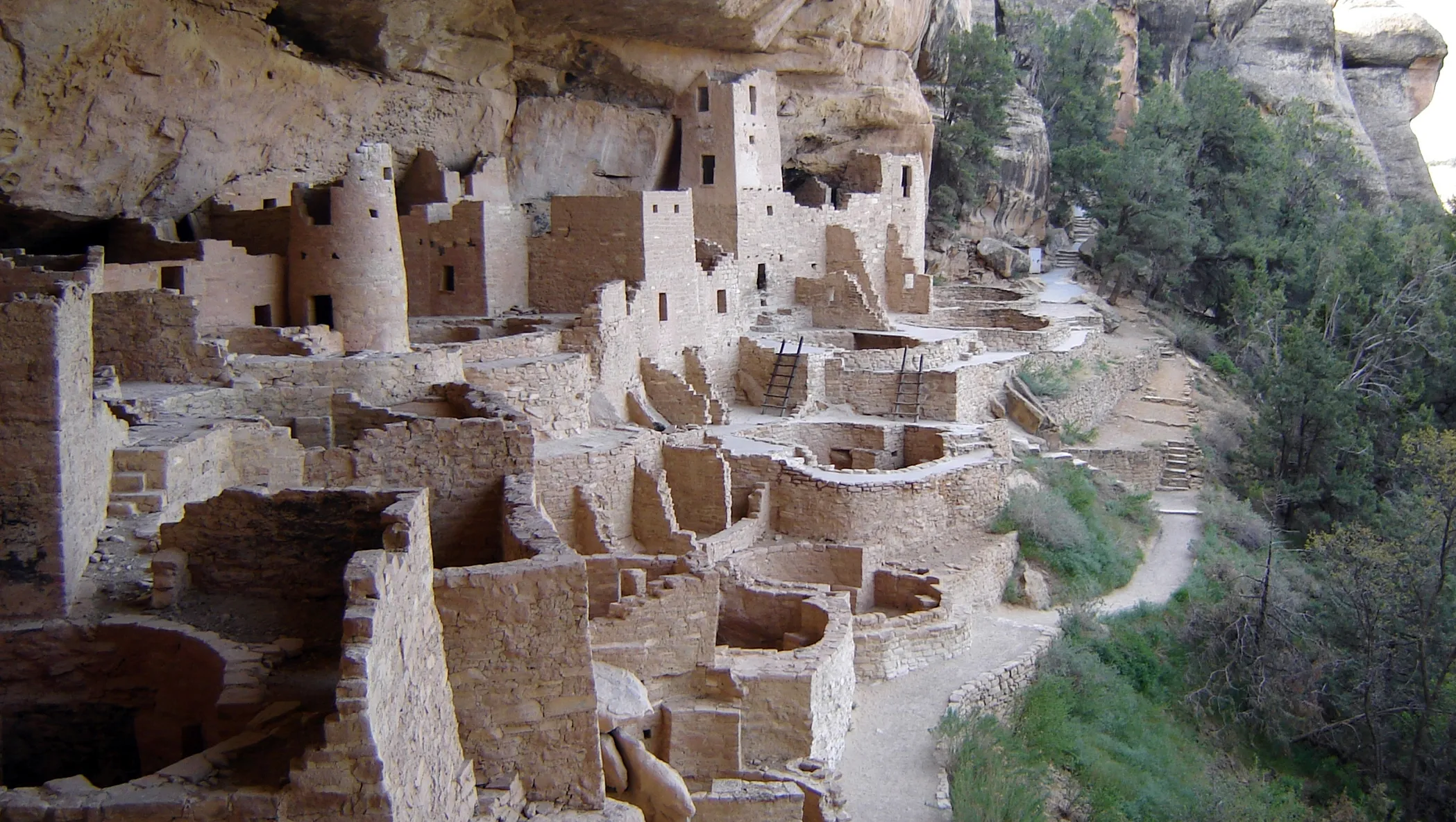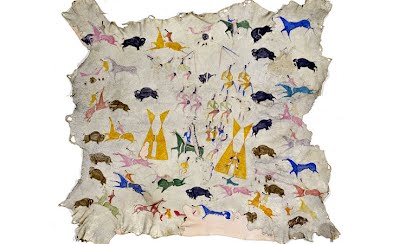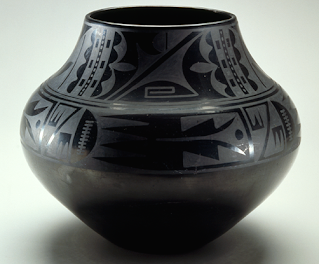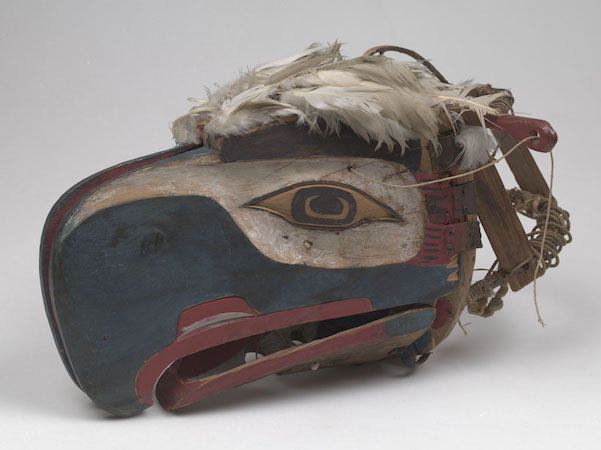AP ART HISTORY: Indigenous American Art
0.0(0)
0.0(0)
New
Card Sorting
1/24
Earn XP
Description and Tags
Study Analytics
Name | Mastery | Learn | Test | Matching | Spaced |
|---|
No study sessions yet.
25 Terms
1
New cards
Mesa Verde
Montezuma County, Colorado; Ancestral Puebloan (Anasazi); 450-1300; sandstone

2
New cards
Mesa Verde: Form
Built into cave; dwellings built both on top and in/along the mesas, over 500 structures; made of stone, mortar and plaster;
3
New cards
Mesa Verde: Function
Used for ceremonies, though not specifically the MV structures, both residential and ceremonial; originally covered, but no roofs now, space around buildings was a plaza; circular and rectangular rooms for living; smaller rooms for storage
4
New cards
Mesa Verde: Content
Kivas- underground circular rooms for ritual purposes; murals and other paintings decorated the walls; storage rooms off the hearth has holes to reach into
5
New cards
Mesa Verde: Context
Mesa Verde means green table - refers to mountains; Ancestral Puebloans lived in the MV for about 850 years (450-1300 C.E); 500-1300 CE, Ancestral Puebloans were mainly sedentary farmers; Exact reasoning for the cliff dwellings is unknown, possibly provided protection from invaders, snow, and provided shade. There could also have been a ceremonial or spiritual reasoning; Abandoned around 1300 CE probably due to drought, lack of resources, or violence
6
New cards
Painted Elk Hide
attributed to Cotsiogo (American name; Cadzi Cody); Easter Shoshoe, Wind River Reservation Wyoming; 1890-1900 C.E; Painted elk hide

7
New cards
Painted Elk Hide: Form
Pigment in elk hide; combination of free-hand penciling and stencil; colorful animals and human-like figures
8
New cards
Painted Elk Hide: Function
Economic and cultural benefit of the Wind River Reservation; created sales from white visitors and led them to attend Sun and Wolf dances; helped move tribe artwork into modern world by making it contemporary
9
New cards
Painted Elk Hide: Content
Combines contemporary tradition to the historical record of tribes; Displays important ritualistic Sun Dance and Wolf Dance; Sun Dance was especially ceremonial and used to honor deities; Depicts daily life on the Wyoming reservation such as men hunting buffalo on horses and women sitting near fires at a campsite (teepee); Warriors shown in feathered war headdresses to show their honor and importance
10
New cards
Painted Elk Hide: Context
Painting on animal hides is a tradition in Great-Basin region; preserved history; era of poverty on Wind River Reservation in Wyoming - artwork kept the economy and culture alive
11
New cards
Black on Black Ceramic Vessel
Maria Martinez and Julian Martinez; Puebloan Culture, New Mexico; Mid 20th century; Blackware ceramic, pigment, volcanic ash

12
New cards
Black on Black Ceramic Vessel: Form
Ceramic; mixed with volcanic ash for black color; pot made by building up coils (not a wheel); olla - traditional shape used by Puebloans for storing water (rounded pot)
13
New cards
Black on Black Ceramic Vessel: Function
ollas and similar dishes hold water, store seed and grain, used for cooking; The Martinez's pieces became known as fine art and were purchased for the purpose of being art
14
New cards
Black on Black Ceramic Vessel: Content
Images on pot based on rain clouds, feathers, corn and rivers.
15
New cards
Black on Black Ceramic Vessel: Context
Transformed functional tradition of Puebloan pottery into symbols of culture and works of decorative art that became status symbols for many American collectors;
16
New cards
Great Serpent Mound
Adams County, Ohio; Mississippian (Eastern Woodlands); 1070 C.E; Earthwork/Effigy

17
New cards
Great Serpent Mound: Form
Dirt; 1300 feet long (1/4 mile); 1-3 feet high; serpents tail wraps around itself; The mound conforms to the natural topography of the area; The head faces east and the tail faces west; Head aligns with summer solstice sunset; Tail points to the winter solstice sunrise.
18
New cards
Great Serpent Mound: Function
Snakes, which were seen to have supernatural powers, were often incorporated into spiritual rituals; astrological alignment; may have served as a natural compass could have marked Haley's Comet event; debate over purpose continues
19
New cards
Great Serpent Mound: Content
Snake, slightly crescent shaped; possibly rattlesnake;
20
New cards
Great Serpent Mound: Context
Created by Native American tribes (primarily the Fort Ancient culture) who lived in the valleys of the Ohio, Missouri, Mississippi, and Illinois rivers before settlers of European descent came to the region in the 19th century; people who made this lived in settled agrarian communities; Many Native American cultures east of the Mississippi believed the snake to be a powerful deity of the underworld;
21
New cards
Kwakwaka’wakw Transformation Mask
Kwakwaka’wakw; Northwest Coast of Canada; Late 19th Century; red cedar wood, string, and paint; no known artist; transformation mask

22
New cards
Kwakwaka’wakw Transformation Mask: Form
Large, exaggerated bird head; large beak; opens up to show human-like face; multiple bright colors (blue, red, white, yellow, black, brown); hair made of string and feathers
23
New cards
Kwakwaka’wakw Transformation Mask: Function
creates powerful effect during cermomies; worn during potlach (ceremonial feast to displace wealth) where host displays status; conveyed high social status; portrayed familiy genealogy - family crests; passes betwwen family members
24
New cards
Kwakwaka’wakw Transformation Mask: Content
Shape of eagle; pull cord to open mask; open form looks like bird spreading its wings; human face is of an ancestor
25
New cards
Kwakwaka’wakw Transformation Mask: Context
Mask worn during dance ceremonies; dancers open mask while dancing; takes years to make; carving techniques changed after tools introduced by Europeans - brighter synthetic colors also introduced; integral part of culture; work with cloak made of red cedar bark